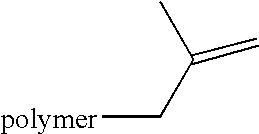Polyalkene amines with improved applicational properties
- Summary
- Abstract
- Description
- Claims
- Application Information
AI Technical Summary
Benefits of technology
Problems solved by technology
Method used
Image
Examples
example 1
Preparative Example 1
Preparation of a Polyisobutene Amine Formulation Having Improved Cloud Point
[0110] Polyisobutene amine (PIBA) prepared according to EP-A-0 244 616 is admixed with MIHAGOL M in the PIBA / solvent mixing ratio specified there in Example 1 (62.5:37.5 parts by weight).
[0111] In the same manner, an inventive formulation was prepared, except that a mixture of 66.7 parts of PIBA and 33.3 parts of MIHAGOL M was used.
[0112] Cloud point and pour point were measured for both formulations. The results are summarized in the following Table A:
TABLE APrior artInventionCloud point−27.6° C.−29.4° C.Pour point −27° C. −27° C.
[0113] Surprisingly, a significant improvement in cloud point could be achieved in accordance with the invention.
example 2
Preparative Example 2
Preparation of a Polyisobutene Amine Formulation Having Improved Low Temperature Properties
[0114] 500 g of polyisobutene having a molecular weight Mn of 1000, 269.2 g of a solvent composed of (80% by weight of MIHAGOL M and 20% by weight of LIAV 230) and 2.8 g of cobalt octacarbonyl are heated at 185° C. for 5 h in a 2.5 l autoclave having a lift stirrer with stirring under 280 bar of 1:1 CO / H2. Subsequently, the mixture is cooled to room temperature, the catalyst is removed with 400 ml of 10% aqueous acetic acid and the mixture washed to neutrality. The resulting oxo product is treated with 1 l of ammonia, 300 g of ethanol and 100 g of Raney cobalt in a 5 l roller autoclave under a hydrogen pressure of 200 bar at 180° C. for 5 h. After the mixture has been cooled, the catalyst is filtered off, excess ammonia is evaporated off and the solvent is distilled off.
[0115] The polyisobutene used is a highly reactive polyisobutene according to DE-A-2,702,604 having a ...
example 3
Preparative Example 3
Preparation of a Polyisobutene Amine Formulation Having Improved Low Temperature Properties
[0118] Preparative Example 1 was repeated, except that the solvent used was MIHAGOL M and / or LIAV 230 in various mixing ratios. The polyisobutene amine polymer to solvent mixing ratio in the end reaction product is 66:34. Pour point and storage stability of the resulting product were determined for the different batches. The results are compiled in the following Table C:
TABLE CMihagol:LIAV ratio1)100:080:2070:3050:500:100Pour point−27° C.−33° C.−36° C.−39° C.−51° C.Storage stabilityMany crystallineFew crystallineClear, fluidClear, fluidClear, fluidat −35° C.precipitatesprecipitates
1)Weight ratio
[0119] The results show that suitable variation of the solvent enables further surprisingly significant improvements in the storage stability.
PUM
| Property | Measurement | Unit |
|---|---|---|
| Temperature | aaaaa | aaaaa |
| Temperature | aaaaa | aaaaa |
| Temperature | aaaaa | aaaaa |
Abstract
Description
Claims
Application Information
 Login to View More
Login to View More - R&D
- Intellectual Property
- Life Sciences
- Materials
- Tech Scout
- Unparalleled Data Quality
- Higher Quality Content
- 60% Fewer Hallucinations
Browse by: Latest US Patents, China's latest patents, Technical Efficacy Thesaurus, Application Domain, Technology Topic, Popular Technical Reports.
© 2025 PatSnap. All rights reserved.Legal|Privacy policy|Modern Slavery Act Transparency Statement|Sitemap|About US| Contact US: help@patsnap.com

